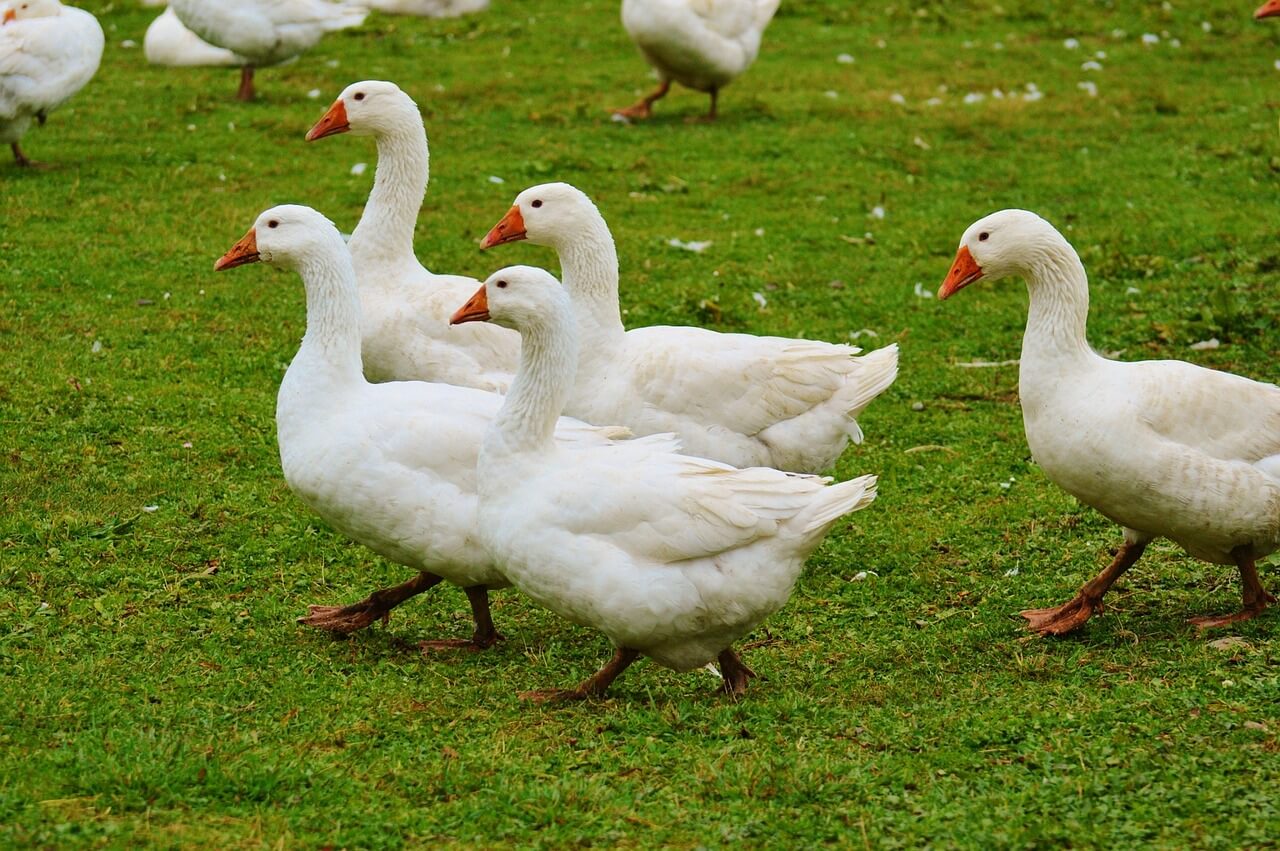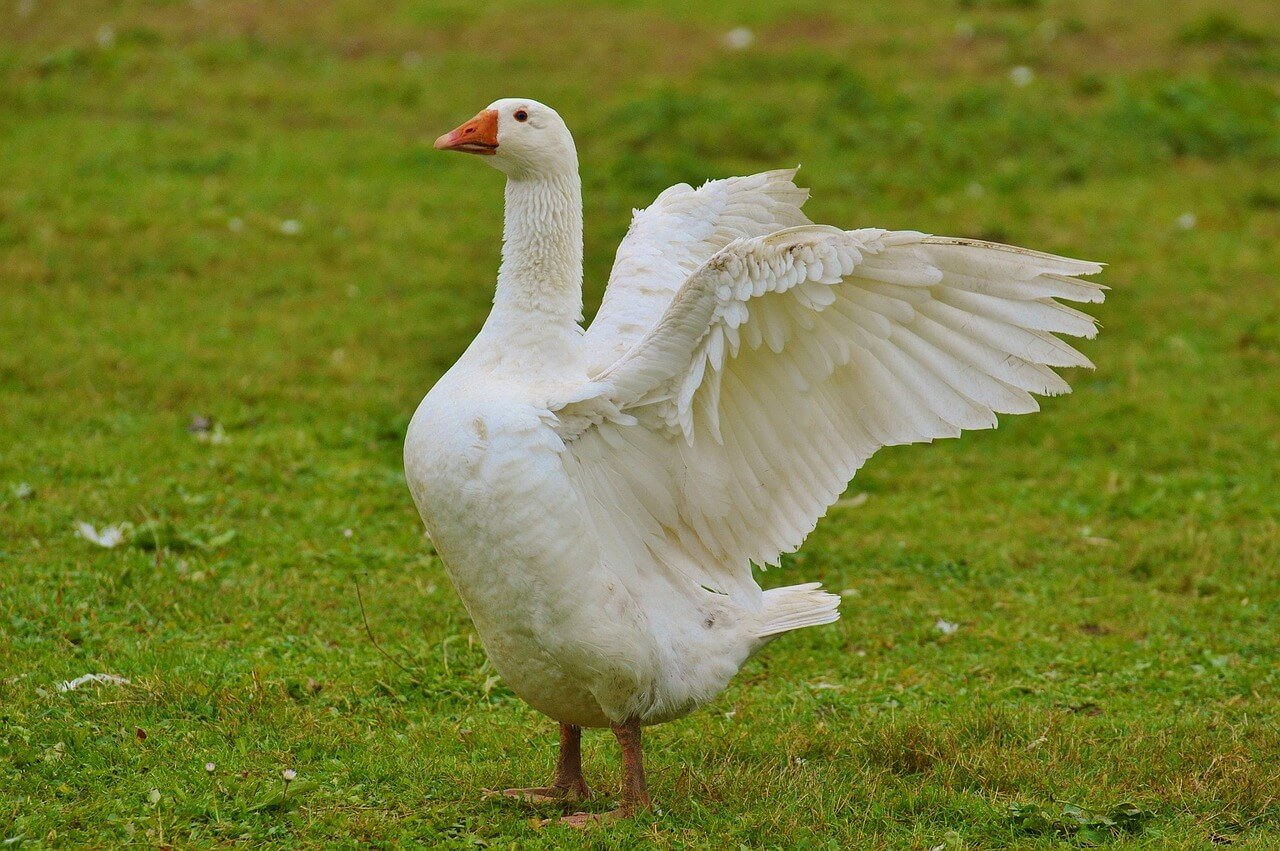If you’re new to keeping geese, then how to tell a goose from a gander can be pretty tricky. The plumage of most breeds is identical in both males and females, and they are of a similar size and build. There are, however, some tell-tale behavioral signs to sort out the boys from the girls. While more experienced keepers use vent sexing to tell them apart. Let’s see if you know your goose from your gander.
What You'll Learn Today
Goose Vs. Gander

A female goose is called – well, a goose! While male geese are called ganders.
Female geese are shy and generally quieter than males. The fellas are typically more aggressive and come forward to defend their wives when approached, or if they’re feeling threatened.
The call of a goose is lower in tone than the ganders, which in contrast is high pitched and quite shrill. The gander will usually get vocal before the goose.
Goose Traits
- A hoarse, harsh, honking cry
- A soft, rounded abdomen
- Wide pelvic bones for egg-laying
- She will retreat behind the gander when approached or threatened
Gander Traits
- A shrill, high pitched voice
- A larger body than the goose
- Slightly longer neck than the female
- The head may be a little bigger
- He protects the flock and comes forward noisily when approached
- Chinese geese have a knob on their beak at the base
A common myth is that ganders have two lobes (fat deposits) between their legs, making a W shape. In contrast, geese only have one that looks more like a U shape. Unfortunately, this isn’t actually the case and varies with breed.
If the standard of perfection for your breed of goose states it should have a specific number of lobes, and your goose or gander doesn’t conform, it is a conformation fault and not a way to determine their sex.
How to Identify Geese Gender

To make a definitive identification, you can use vent sexing on birds over 7 months of age. This involves manipulating the vent to see if a penis is present or not.
Geese, like ducks, swans, ostriches, and emu’s, retract their penis inside of their bodies to keep them moist and safe.
Vent sexing is much easier to do in the spring when the birds are sexually active. Done correctly it won’t hurt the animals, providing you handle them with care. It’s better to get someone experienced to help if you’re unfamiliar with the practice.
How to Vent Sex Your Birds
- Pick up your goose, ensuring you keep the wings folded against its sides as they can cause you injury.
- If you’re new to vent sexing, it can be easier to sit down on a chair. Carefully turn your goose over so the tail is over your knees and he, or she, is lying with their back resting on your legs.
- Now tuck the goose’s head under your least dominant arm.
- Make sure they are being well supported in your lap, if they feel insecure they will try to flap.
- Place your least dominant hand on the tail and push it slightly downwards towards the floor. At the same time, using your dominant hand, put gentle pressure above and around the vent.
- In a male, you will be able to feel a hard mass around the vent, while in a female, the area is soft.
- The interior of the vent will pop up, and if you continue to apply gentle downward pressure, a gander’s penis will appear. It should be fairly long and corkscrew-shaped.
- Some ganders lose the ends of their penis, so vent checking is important, as a gander without a penis is infertile because he cannot penetrate the female and fertilize her eggs.
- Just to be clear, a female goose won’t produce a penis when pressure is applied to her vent.
A young gander only has a small penis, compared to a mature male.
Some species of geese can be sexually differentiated just by their feather color. We will look at this more in “auto-sexing” below.
In this video, you will be able to see from the behavior of the birds, which is a goose and which is a gander.
In this video, you will see how to vent sex adult geese and how to notice if your gander is unfertile.
How to Tell if a Baby Goose is Male or Female
Experienced breeders can tell if a baby goose is male or female by vent sexing in a similar way to mature geese. An inexperienced handler can easily hurt the young birds and damage their sex organs.
To vent sex day old goslings, you hold the gosling in your left hand so the young bird is bottom up with its feet facing you. The feet are held down against the gosling by your thumb. Use your first finger of the same hand, to gently bend the tail upwards towards the goslings back.
With your right hand, separate the soft down with your thumb and forefinger to locate the vent. Gently applying a little pressure around the vent, you will see a tiny protrusion pop up. On a male, you will also see a very tiny penis, while no penis will appear on a female. The penis itself is curled and very thin and tiny.
Quite often, the gosling will empty its waste onto you, so be prepared with the hand sanitizer!
Auto Sexing Geese
There are some breeds of geese where the male and female have distinct color differences. There are two American breeds that are auto-sexing, the Pilgrim Goose and the Choctaw, also known as the Cotton Patch Goose.
Adult male Pilgrim geese are almost completely white, while the females are mostly gray. This helps to make the distinction between them very easy to spot.
Cotton Patch geese are a little less simple, as males and females both have a bigger mix of white and gray markings, but the gander is much whiter than the female, who exhibits a gray saddle.
Sadly the Pilgrim goose is under threat of extinction, while the Cotton Patch is critically endangered.
Other autosexing breeds include the West of England, Shetland, and Normandy. In all breeds, the male is predominantly white while the female is a mix of gray and white.
In several historical documents and books, references have been made to auto-sexing breeds of geese, but unfortunately, they are rarely referred to by name.
It has been concluded that most likely auto-sexing geese have long existed in small populations in various locations around the world. Predominantly Europe, the United Kingdom, North America, and Australia.
Pilgrim chicks can be identified by color too. At a day old, females are olive-gray with dark bills while males are silver yellow with pale bills.
Conclusion
If you only have a small number of geese, you’ll likely be able to tell them apart fairly easily. Larger numbers can be leg or wing tagged once you know what they are, to make future identification simpler.
For novice handlers, the best method of telling a goose from a gander is by watching what the geese do when you approach. Ganders, being defensive, will typically come toward you, taking on a low stance with their necks outstretched, often hissing and screeching.
Females tend to move behind the males and very rarely show aggression unless they are defending young.
If you’d like to learn more about geese, we have other articles you may find helpful on our site, so why not take a look at this one about how to clip their wings?
Is it bad to have only 1 goose & 2 ganders! Will they fight over the goose? One of my ganders is all white , the other has some gray & black markings & a little tuft on it’s head & it has a black bill. Can you tell me the breed with that info. The 2 whites ,I believe are Emden. Thank you for your site!
Hi Rhea,
You don’t say how old your geese are. If they are old enough to mate it is quite probable that your two white Emden geese will pair up and the other will be left as the odd one out. He may rape your female, which could be problematic and may cause fights. It probably isn’t an ideal situation. Also as the males mature they do become more aggressive, having one to deal with maybe enough!
As far as breed, there are a few types of tufted geese. From your description, he may be a tufted Toulouse, but the best way to check may be to do a quick image search on google for tufted geese and see which most closely resemble him.
Good luck!
What were you doing? The gander may sue you for ‘invasion of privacy’…
I thought all geese were mean and would attack you, like they did my mum when she was 3 yrs old, leaving her bruised all over. To this day she hates geese and has no problem serving them up for dinner, which I just learned are the infertile males, apparently! Lol!! Thanks for the lessons!!